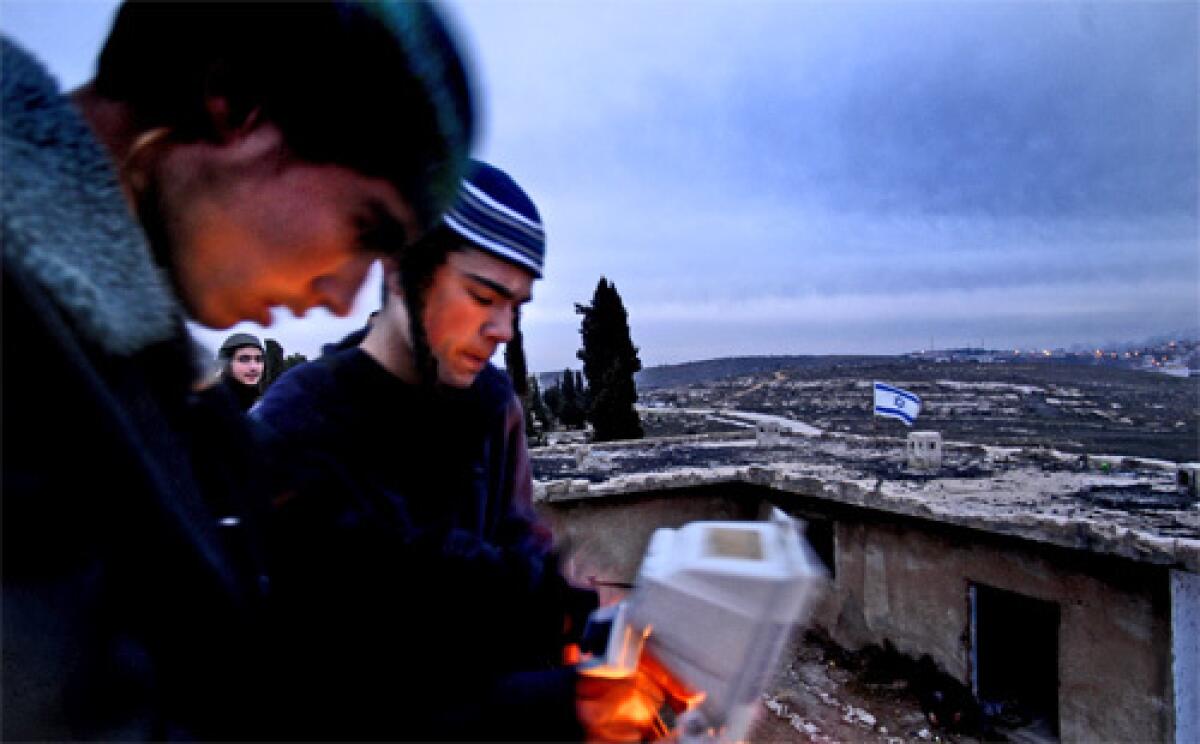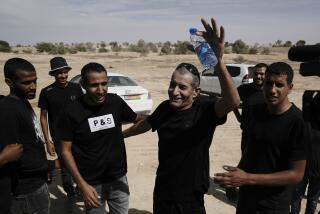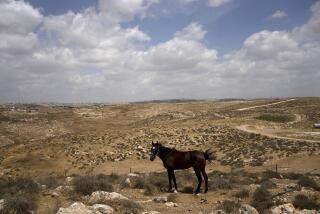Israel’s ‘hilltop youth’ are settling in

GIVAT HAOR OUTPOST, West Bank — It was a festive night for the teenage squatters in this renegade hilltop camp. A rabbi was on his way, and they were cranking up a generator, stringing light bulbs and arranging benches, turning what had been a Palestinian family’s barn into a synagogue.
Suddenly the group fell silent. An Israeli soldier and a policeman had trudged up the slope and were demanding to know who was in charge. No one would tell them.
After a few tense minutes, the uniformed intruders left. The “hilltop youth” had prevailed again.
As Israeli and Palestinian leaders try to end decades of conflict, this outpost and other unauthorized Jewish settlements have become a battle line between the Israeli government and a settler movement unwilling to give up any part of the West Bank.
Under commitments made to President Bush at a November peace conference, Israel is supposed to dismantle about 50 outposts as a first step in negotiations on definitive borders and other terms of a final accord. Instead of vanishing, however, the outposts are growing, swollen by a loose-knit group of young second-generation settlers believed to number in the hundreds.
Since this outpost was set up in December, Israel’s paramilitary border police have chased away its occupants at least a dozen times, but never for long. “They come up the hill, we go down the hill, we come back two hours later,” said Yaakov Cohen, 17, shrugging off the timid evictions.
About 100 outposts, in addition to 126 settlements formally authorized by Israel, occupy West Bank land the Palestinians seek for a future state. Some of the bigger outposts have a few hundred residents each and de facto government support in the form of running water, electricity, paved streets and schools.
Bush pressed the issue last month after his motorcade passed this outpost during a visit to the region.
“The agreement was, ‘Get rid of outposts, illegal outposts,’ and they ought to go,” he said at a Jerusalem news conference. Standing beside him, Israeli Prime Minister Ehud Olmert replied: “This was discussed. . . . We ought to fulfill our commitments, and we will.”
But that resolve has provoked new land invasions by the hilltop youth, guided by a belief that the Torah commands Jews to settle all of biblical Israel no matter what modern Israel’s elected leaders say.
Since the peace conference in Annapolis, Md., young Israelis have set up or expanded nine outposts, according to Peace Now, an Israeli advocacy group critical of the settlements.
The outpost here, whose Hebrew name means “Hill of Light,” is populated by about 40 boys and girls who attend religious high schools in nearby settlements during the day. At night they climb the hill, cook by campfire and sleep on mattresses in a complex of farm buildings, taking care to maintain a daily presence.
They say they’re determined to outlast the police and build a viable community on the hilltop, just north of Ramallah.
“It’s not Bush’s decision. He isn’t the landlord,” Cohen said. “Neither is Olmert.”
“God is the landlord,” the teenager insisted.
The titled owner is a Palestinian American family -- the Khalaf brothers and a cousin, two living nearby in the West Bank and two in Ohio. The Jewish youths occupied the seven-acre farm in December, claiming it had been abandoned; the Khalafs say the land was temporarily unattended between olive seasons.
Israeli police officials have authenticated the Khalafs’ land title but failed to make good on a promise in December that the settlers would be removed from the farm.
When three Khalaf men tried to visit their property more recently, they were turned back by the Israeli army, which had declared it a closed military zone to prevent any violence between settlers and Palestinians.
“But the settlers are still there,” complained Midian Khalaf, 40, a Cleveland grocer, pointing to an Israeli flag over the farm that is visible from his family’s West Bank home in Al Birah. “The longer they stay, the more likely their outpost will become permanent.”
Many full-fledged settlements started exactly this way, as camps or small clusters of trailers. Today, 282,200 Jews are settled in suburban-style communities funded by the Israeli government on West Bank land captured in the 1967 Middle East War.
Most governments consider all Jewish settlements in the West Bank a violation of international law, which forbids populating land seized in war. Palestinian leaders say the settlements are a major obstacle to peace.
Israel asserts that the West Bank is disputed territory and that the settlements are legal.
Olmert has nonetheless pledged to dismantle unauthorized outposts while trying to negotiate border adjustments that would enclose the biggest settlements on the Israeli side. He has public support; 53% of Israelis polled by Tel Aviv University in December favor such a course.
Yet he is reluctant to move decisively. Part of his fragile coalition opposes any concessions to the Palestinians until they live up to their commitment at Annapolis to curb violent attacks on Israel.
Also, Israel’s military and civilian hierarchies have supported or tolerated outposts for years and are ambivalent about helping Olmert abolish them for the sake of an uncertain peace.
“The Zionist ideal of settling the land is deeply embedded in Israeli society,” said Gershom Gorenberg, author of “The Accidental Empire,” an early history of the settlements. “When a politician is told that settlement is now detrimental to Israel’s long-term strategic interest, this is something extremely difficult for him to absorb.”
Even more troublesome is the specter of violent resistance by the hilltop youth, who emerged as an unruly force several years ago. They have left comfortable settlements close to Israel to stake claims deeper inside the West Bank, displaying a rugged back-to-the-land lifestyle and anarchic contempt for authority. They are linked by settler websites and recruit volunteers online.
Cohen and some of his comrades are veterans of a major clash with police two years ago at a nearby outpost called Amona. They say they’re ready to fight and risk imprisonment to defend other outposts.
Olmert’s government prevailed at Amona, demolishing nine Jewish homes illegally built on private Palestinian land. But televised images of the clash, which left more than 200 soldiers, police and demonstrators injured, shocked Israelis; since then, the government has been reluctant to confront the settlers head on.
The Givat Haor outpost looks less like a battle-ready fortress than a pioneer camp for religious bohemians. The boys sport curled sidelocks, scraggly beards, knitted yarmulkes and baggy jeans; the girls wear long, modest dresses and keep their heads covered. Boys and girls stay apart, praying on opposite sides of a green plastic sheet.
The guiding hand of adults came into view as more than 100 people crowded in for the inaugural religious service.
Rabbi Dov Lior, from a far-right enclave near the West Bank city of Hebron, led the service and congratulated the settlers for “serving your country.” Daniella Weiss, a veteran ideologue of the settler movement, came to promote a campaign to double the number of outposts this summer.
The young settlers had another reason to celebrate.
A judge had just ordered the release of seven girls from the outpost who had been detained in a police sweep. Defying the legal system, the girls had refused to give their names to police, and their jailing had sparked protests and sympathetic media coverage.
After that incident, the settlers say the police raids became far less frequent. That freed them to clear a dirt road to the outpost and start trucking in furniture through the Palestinian village of Beitin, which shares the same hill.
Now the village’s mayor, Diab Yasin, is worried about his own hilltop youth.
“This has been a peaceful village, but now our young people want to fight the settlers,” he said. “If we let them, somebody will get hurt.”
More to Read
Sign up for Essential California
The most important California stories and recommendations in your inbox every morning.
You may occasionally receive promotional content from the Los Angeles Times.










